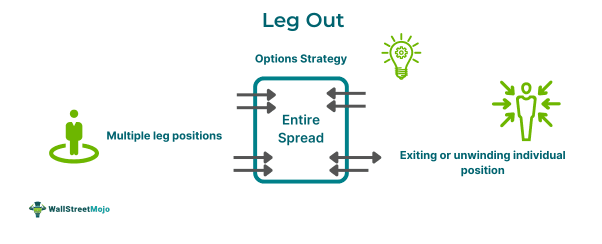Table of Contents
Leg Out Meaning
Leg out refers to an options trading strategy, which simply means exiting out one position at a time from complex multi-leg options transactions. Leg out, in simple terms, is a single piece of the options strategy known as spreading. A spread involves taking multiple positions and earning from price differences.

In an option trading spread, traders buy and sell options on underlying securities with different strike prices and expiration dates. Therefore, multiple positions form a spread and rather than closing all the positions, a trader exists one leg at a time of the entire derivative position. This strategy is applicable for both call and put options.
Key Takeaways
- Leg out is to unwind or close out one individual position of the existing options trading spread or combo and not the entire strategy.
- A leg is one single position taken. So, buying shares of a company is a trader's first leg, and then selling the same shares later indicates the second leg.
- Leg out refers to taking a short position selling the underlying securities. Conversely, when a trader takes a long position, it is called leg in.
- Although it sounds like a simple technique, it demands trading discipline, trend interpretation knowledge and decision-making skills.
Leg Out In Options Trading Explained
Leg out in options trading is the existing individual position from a spread or combo. It allows a trader to exit a certain part of the whole spread position. Options trading allows traders to buy or sell the right to trade an underlying asset at a predetermined price at a future date. The whole financial instrument is based on the premise that the buyer has the option to exercise the contract with no obligation.
In simple terms, a leg out is taking a short position; likewise, there is a leg in, which means entering a short position. Hence, both are opposite to each other and with leg out, traders keep their choices open to operate flexibly in case an opportunity arises. A leg out can be performed with all types of options positions such as calendar spreads, straps, stripes, straddles and strangles.
A leg out from a multi-leg options trading scenario can turn losses or neutral positions into profits or at least increase the overall profit levels. Still, a trader must have the skills to interpret short-term market trends and make quick calculations and decisions, posing the right time to leave out from a specific position. Options trading itself is considered highly risky and only performed by advanced traders and investors, as few people have the required risk appetite, knowledge, patience and confidence to pull off a successful options trading.
Examples
Here are two examples of leg out -
Example #1
Suppose Jacob is a wise options trader. He has been currently eyeing an underlying security. Jacob wants to put a one-is-to-two ratio spread using 45 and 36 strike puts after consulting with his trader friends and asking a broker to quote a single-unit spread. Jacob finds that he can purchase the 45 put on a floor exchange and sell two of the 36 put on the electronic exchange screens. In this scenario, Jacob legged into the trade.
After a few weeks, the 36 strike puts declines in value. Jacob now wants to exit these small puts by purchasing them back on the screen at a very low price. This way, Jacob legged out the put part of the option spread. It is a very simple leg-out example in options trading. When Jacob does this, the rest of the trade legs remain intact.
Example #2
In another hypothetical example, let us say Rachel executes an options straddle. This involves a call and a put with similar expiry dates. At first, her broker buys a call and then a put. The broker makes the purchase almost simultaneously. But almost immediately, Rachel wants to get out of the put transaction. She calls her broker and asks him to conduct a leg out of the put.
The broker legs out by selling the put Rachel just purchased. Now, again, this is a very simple example of leg out. Rachel, like many investors, got cold feet, or maybe she got some market intel that made her change her mind. Legging out can leave Rachel with unusual risk and she may have to incur increased brokerage fees.
Advantages And Disadvantages
The advantages of leg out are -
- Traders can exit positions one at a time without unwinding the whole trading strategy with multiple positions.
- It can be done for either call or put options.
- When one leg is exited, it does not affect the whole spread.
- With changing market dynamics, leg out assists in regulating the strategy rather than closing it entirely.
- Traders can lock profits or cut losses by legging out a position.
The disadvantages of leg out are -
- It demands trading discipline and is mostly done by experienced investors and traders.
- Legging out of one position still keeps the investor open to the risk of other legs.
- The initial technique may look easy, but it isn't very easy to implement.
- Mistiming the legs or executing in the wrong order will throw the trader in a tight position with no profit.
- There exists a leg risk that denotes unfavorable market movements.
